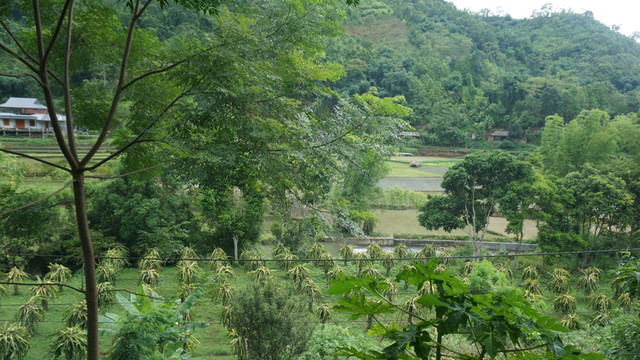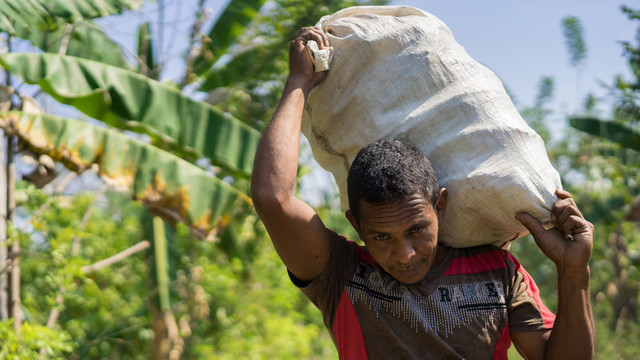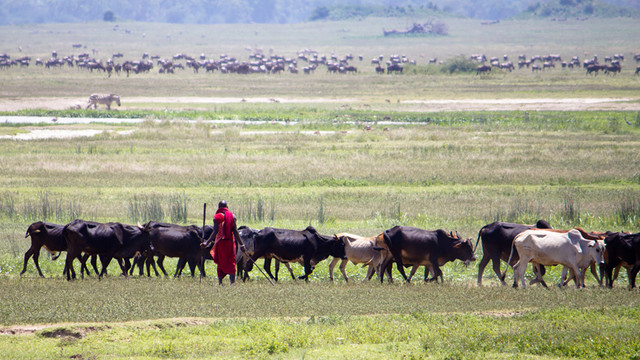Escalating local climate resilience finance
A new IIED report offers 30 practical options to help local people build vital resilience into their livelihoods, landscapes and food systems and calls for an urgent increase in climate finance to and through local organisations.


Indonesian smallholder farmers plant diverse crops for climate resilience (Photo: copyright Duncan Macqueen)
Many of us were shocked at how little COVID-19 trade and travel restrictions reduced carbon dioxide emissions in 2020. Despite the world grinding to a virtual halt, emissions fell by just 6.4%, or 2.3 billion tonnes; and the dip is not expected to last.
Climate risks continue to escalate, with extreme weather events in 2021 so outside the range of past experience that they even knocked COVID-19 off the front pages now and then.
Latest estimates suggest that, by 2050, we can expect an additional 250,000 climate-related deaths from heat and disease exposure, and a further 529,000 from food shortages every year, with a total of 720 million more people pushed into extreme poverty worldwide.
Smallholder farmers bear the brunt
At the sharp end of this are almost 1.3 billion people who depend on forest and farm landscapes for their livelihoods.
Among them, smallholder farmers supply at least one-third of the world’s food. For them, increasing temperature extremes, more variable rainfall, droughts, storms, flooding, and pest and disease outbreaks have become the norm. Climate resilience is now a matter of survival.
Yet, only 10% of climate finance trickles down to the local level and as little as 1.7% reaches local Indigenous Peoples’, community and smallholder organisations. As a result, poor people often pool their own scarce resources within local organisations that invest in practical climate resilience activities.
Practical options for building resilience
Climate resilience is not complicated. Rather, it is about finding ways to persist, adapt or transform at individual, group and system level. IIED’s new report reviews global resilience literature that identifies 30 practical options for local people to build their own resilience. This involves making changes that are:
- Social – what their organisations offer
- Ecological – how they manage their farms and forests
- Economic – what they sell, and
- Physical – what technology and infrastructure they choose to invest in.
The report finds that, despite their limited resources, smallholder farmers are already acting on climate resilience out of necessity.
Their own member based organisations are stepping in to help them. Analysing case studies – commissioned by the Forest and Farm Facility (FFF) – of climate resilience actions by local organisations in Bolivia, Ecuador, Ghana, Kenya, Madagascar, Nepal, Tanzania, Togo, Vietnam and Zambia against our 30 climate resilience options, we find that even the most fragile are pursuing at least half of them.
Local organisations: best placed to support smallholders
One of these organisations is the Tanzania Tree Growers Associations Union (TTGAU). Established in 2017, it brings together 146 regional tree grower associations representing 10,026 smallholders (3,224 women and 6,802 men).
Most TTGAU members are subsistence farmers – growing maize, beans, wheat, potatoes and horticultural crops to earn a living – whose income is threatened by changes in rainfall patterns, increased temperatures and pests and diseases.
For example, in Makete District, traditional staple potato varieties cannot cope with variable rains, and tomato pests are so widespread that farmers are giving up, unable to afford costly sprays to control infestations.
TTGAU encourages diversification into tree planting to reduce risks of total failure and helps women and young people access land through certificates of customary rights of occupancy, allowing them to invest in longer-term crops.
It also supports regional associations take on the role of agro-dealer, supplying seed, fertiliser, pesticides and tools to their members in a timely manner and at a lower cost. By supporting further diversification into commercial beekeeping and avocado farming, it has enabled women’s economic groups to branch out, producing simple but valuable products such as soap and batik.
But it takes money to install better water management systems, and it takes time to understand how to sell avocados. So, although they are clearly best placed to support local people’s climate resilience, organisations like TTGAU and its member associations are constrained by limited investment finance and a lack of peer-to-peer knowledge and technical exchange.
Getting more money where it matters
While the FFF already provides some direct support to local organisations for climate resilience, its partners, the Food and Agriculture Organization, IIED, the International Union for Conservation of Nature and AgriCord are calling for a huge upsurge in climate finance to and through these organisations to build vital resilience into smallholder livelihoods, landscapes and food systems.
Forest and farm organisations are locally trusted conduits of knowledge, inspiration and financial support. Often grouped into regional associations and national unions or federations, they offer a unique organisational pathway to scale up efforts to build climate resilience.
Getting more money where it matters to build climate resilience can help reduce poverty and increase food security, biodiversity conservation, forest landscape restoration and climate change mitigation. The collective scale of smallholders means that benefits will be felt at a planetary scale.



